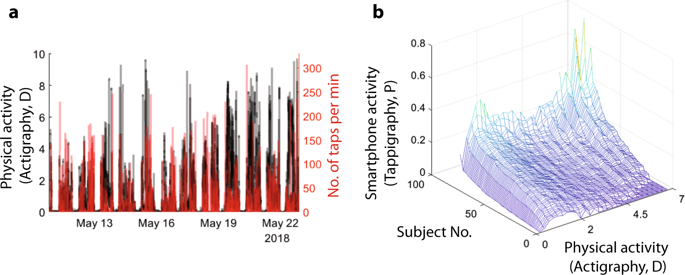npj Digital Medicine ( IF 15.2 ) Pub Date : 2019-07-29 , DOI: 10.1038/s41746-019-0147-4 Jay N. Borger , Reto Huber , Arko Ghosh

|
Body movements drop with sleep, and this behavioural signature is widely exploited to infer sleep duration. However, a reduction in body movements may also occur in periods of intense cognitive activity, and the ubiquitous use of smartphones may capture these wakeful periods otherwise hidden in the standard measures of sleep. Here, we continuously captured the gross body movements using standard wrist-worn accelerometers to quantify sleep (actigraphy) and logged the timing of the day-to-day touchscreen events (‘tappigraphy’). Using these measures, we addressed how the gross body movements overlap with the cognitively engaging digital behaviour (from n = 79 individuals, accumulating ~1400 nights). We find that smartphone use was distributed across a broad spectrum of physical activity levels, but consistently peaked at rest. We estimated the putative sleep onset and wake-up times from the actigraphy data to find that these times were well correlated to the estimates from tappigraphy (R2 = 0.9 for sleep-onset time and wake-up time). However, actigraphy overestimated sleep as virtually all of the users used their phones during the putative sleep period. Interestingly, the probability of touches remained greater than zero for ~2 h after the putative sleep onset, and ~2 h before the putative wake-up time. Our findings suggest that touchscreen interactions are widely integrated into modern sleeping habits—surrounding both sleep onset and waking-up periods—yielding a new approach to measuring sleep. Smartphone interactions can be leveraged to update the behavioural signatures of sleep with these peculiarities of modern digital behaviour.
中文翻译:

通过使用日常智能手机触摸屏交互来捕获睡眠-唤醒周期
身体运动随着睡眠而下降,这种行为特征被广泛用于推断睡眠时间。但是,在激烈的认知活动期间,身体运动的减少也可能发生,并且无处不在使用智能手机可能会捕获这些清醒时段,否则这些时段就隐藏在标准的睡眠测量中。在这里,我们使用标准的腕上加速度计连续记录身体的总体运动,以量化睡眠(书法)并记录日常触摸屏事件(“照相”)的时间。使用这些方法,我们研究了身体的总体运动如何与认知参与的数字行为重叠(来自n = 79个人,累积约1400晚)。我们发现,智能手机的使用分布在广泛的体育活动水平上,但在休息时始终处于高峰。我们从笔迹数据中估计了假定的睡眠发作和唤醒时间,发现这些时间与笔迹学估计值相关性非常高(R 2 = 0.9(表示睡眠开始时间和唤醒时间)。然而,书法几乎高估了睡眠,因为几乎所有用户都在假定的睡眠期间使用了手机。有趣的是,在推定的睡眠开始后约2小时内和推定的唤醒时间前约2小时内,触摸的可能性保持大于零。我们的发现表明,触摸屏交互已广泛集成到现代睡眠习惯中(围绕着睡眠发作和醒来时间),从而产生了一种测量睡眠的新方法。通过现代数字行为的这些特殊性,可以利用智能手机的交互来更新睡眠的行为特征。



























 京公网安备 11010802027423号
京公网安备 11010802027423号